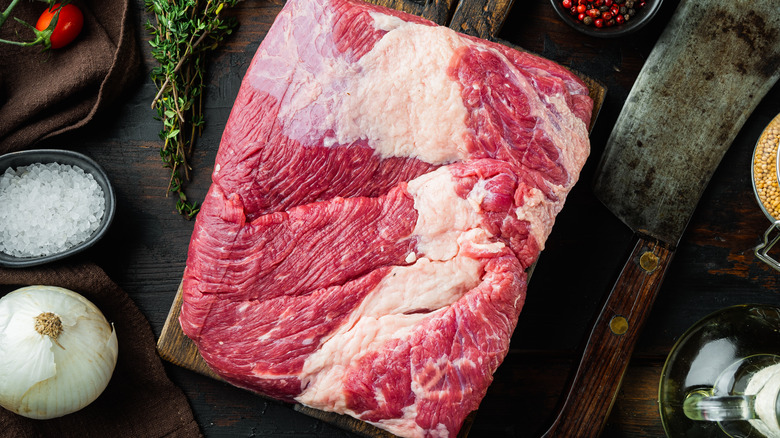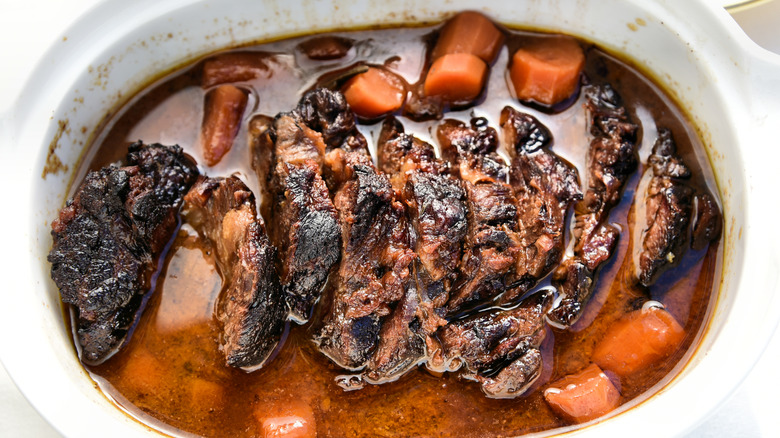Why Andrew Zimmern Never Trims His Brisket
The magic of homemade braised brisket is in its meltingly tender flesh and rich sauce. Those experienced in brisket know that achieving a juicy, soft texture requires a slow cook. What many may not realize, however, is they're making the job harder when they fully trim their beef before cooking it.
That's why chef and former "Bizarre Foods" host Andrew Zimmern advocates on behalf of the fat cap, the layer of white fat attached to the top of the brisket. Why? Because the fat adds flavor and moisture that keeps the beef tender. Zimmern advises cooks to leave it intact because brisket fat "has too much value" to get left behind on the cutting board (per Parade). He does note that "big chunks of extraneous fat" should be removed, however.
The same idea applies to cooks tempted to buy a lean brisket or a flat cut. Brisket is located at the lower front of the cow's chest, comprised of two strong muscles. The flat is lean while the point cut (also called the deckle) has a good amount of marbling. Some cooks suggest you separate the two muscles and trim the deckle's fat, which leaves the flat vulnerable to becoming dry. Instead, follow Zimmern and allow the oven to render the brisket's cap, maximizing the beefy flavor and building a silky sauce in the process. Those smoking their brisket should also consider leaving the fat cap to protect against the grill's dry heat, too.
When (and how much) to trim the brisket
As for the beef itself, take the time to get the right portion from the butcher. Often groceries will display prepackaged flats, which are mostly pink muscle and very little white fat. If the label says, "nose off," that's also a clue the deckle portion was removed.
Instead, request an untrimmed brisket with the fat cap or the point cut attached. At home, you can follow Chef Andrew Zimmern's rule and trim down any significantly thick spots of fat, but otherwise leave the beef alone. Likely an inch is too much — many grill masters prefer ¼ inch — so aim for a maximum ½ inch layer of white when braising and slow cooking.
Once the brisket is fully cooked and flavored with the tallow, you can remove the fat that didn't render. Zimmern suggests doing so right before slicing and serving the meat. This step is easier to accomplish if you cook brisket ahead of time and refrigerate it, as the fat will solidify and appear white against the browned beef. Plus, the braising liquid will congeal and the rendered grease will harden at the top of your storage container, making skimming a breeze.
Other seasonings for a flavorful braised brisket
Cooks can essentially treat fat as another ingredient in their brisket. Unlike when it's smoked, however, the braised protein needs a lot more than salt and a decent fat cap to taste delicious. Since this dish is common in Ashkenazi Jewish households around certain holidays, we suggest embracing some of the common ingredients used to make the meat shine.
For some, a simple mixture of carrots, onions, and red wine will do the trick, evoking a beef stew-like flavor that works well in a slow cooker. White wine-braised brisket makes the braise lighter and brighter, offering a modern twist to the dish. Added root vegetables, like potatoes or squash, can turn the meat into a meal — while seasonal produce, like fennel, can add another aromatic layer. Cooks with a barbecuing background may also borrow an element from the grill and add a hefty pour of BBQ sauce to the pan, along with beef stock, to bring out sweetness and a touch of faux smoke.
Home cooks can also borrow a family secret or two by using sweeter ingredients like prune juice, Coca-Cola, ketchup, or grape jelly in their braise. Even fish sauce and powdered onion soup can join the brisket party, adding a savory element for balance. To excite the palate and cut through the richness, you can finish with a spicy element, like dried chilis or chili sauce, or spices like smoky paprika and cumin.



